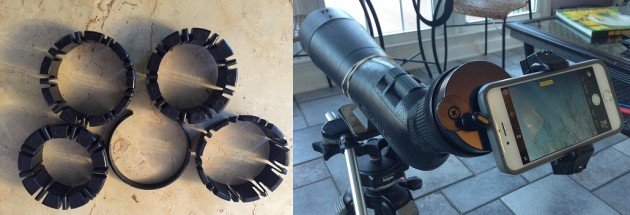Last week I was living it up in beautiful Honduras at the exceptional Lodge at Pico Bonito at the behest of friends at Leica. Ostensibly I was there to check out the brand new line of Trinovid binoculars Leica is releasing (or is it re-releasing?) next month, and I’ll be reviewing those soon on The ABA Blog, but I also had the opportunity to engage in some other fun optics related exploration.
I’ve never been one to really grok the potential of taking photos with my phone through a scope. Sure, I indulged in a little hand-held action in the presence of a good bird, but the results were so middling that I never really saw it as something to spend a lot of time figuring out. This changed last week.
Way back in October at the American birding Expo, I was given an NovaGrade Universal phone-scoping adapter to play around with. It sat in a box in my house for weeks but I through it in my bag for Honduras because Jeff Bouton, Leica rep and stand-up guy, guaranteed that I’d be able to make something out of it. He could not have been more right. For starters, I’d been setting it up wrong. NovaGrade adapters some with a variety of compression rings that tighten around the eyepiece of the scope preventing it from moving.
 Finding the correct compression ring and fitting it in the adapter correctly isn’t the most intuitive thing. It helps to have someone show you. But once you figure it out, the adapter fits tightly on the scope’s eyepiece.
Finding the correct compression ring and fitting it in the adapter correctly isn’t the most intuitive thing. It helps to have someone show you. But once you figure it out, the adapter fits tightly on the scope’s eyepiece.
This is the part where I acknowledge that I’ve never tried the other major phone-scope adapter, PhoneSkope. PhoneSkope works essentially in place of your phone’s case. This is an advantage in that the fit does not have to be adjusted on the device and thus you can get the shot off more quickly, but is a disadvantage in that you have to remove your phone’s case every time you go birding. I’ve also heard that the weight of the phone can pull the PhoneSkope adapter away from the eyepiece at times, but this complaint is not echoed by every user. My sense is that both adapters do what you want them to do with little fuss each with their own pros and cons.
The PhoneSkope adapter is also molder to your specific phone, so when you change phones or upgrade you need a new adapter. The NovaGrade adapter is more expensive, but it’s a one-time buy. It will fit any phone now into the future with minor adjustments.
Once the adapter was secure on the scope, the fun really begins. The quality of smartphone cameras these days is truly incredible. The sort of thing that would have been unthinkable even 5 years ago. So sure, taking photos is great, but I was most impressed by the possibility of video. You get across so much more about the life of the bird in video rather than in static photos. Like I imagine is so with many birders, some of my first truly gob-smacking experiences with wildlife were in the form of PBS nature documentaries I watched as a kid. To have the power to make mini-documentaries literally in the palm of my hand is a heady experience. That’s a long way of saying that I took a lot of short videos while I was in Honduras. Unfortunately, these videos take up a lot of memory space on my phone. Fortunately, I got the 64 GB iPhone 6 when I upgraded last year. I imagined I would fill it up with music. If I only could have seen the future…
Anyway, here are a few videos I took while I was in the tropics. All are taken with an iPhone 6 through a Leica Televid 65 spotting scope using the aforementioned NovaGrade universal adapter. My only issue is that the quality of the videos starts out so poor before snapping into “focus” towards the end. I don’t know why that happens and if anyone has any tips on how to fix that (I’m a novice when it comes to video editing), I’d love to hear them. They look fine if you click through to the YouTube page.
Lesser Roadrunner is certainly not the lesser roadrunner. Aguan Valley, Honduras
Honduran Emerald is Honduras’s sole endemic, and not hard to find in the right, dry-forest, habitat. Aguan Valley, Honduras.
Keel-billed Motmot is a Central American near-endemic, and a target bird for visitors to Honduras. It doesn’t usually show this well. Pico Bonito Lodge, Honduras.
Great Antshrike is a not a bird I ever expected to get a clar look at, let alone an opportunity to video, yet here is is. Lancetilla Botanical Gardens, Honduras.
Of all the video functions on the iPhone 6, I was most impressed by the Slo-motion capture. Up to this point I had only ever used it to take photos of my kid jumping into a pool or something, but the potential for hummingbird videos is obvious even in this crude video.
The amazing thing about all of this is just how easy it was. Get an adapter, figure out how to hook it up to your scope and the only limit is your imagination. The intersection of technology and birding is a wonderful thing. We live in amazing times.











Leave a Comment